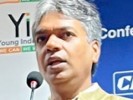Finance Minister Nirmala Sitharaman Wednesday said she declined the offer extended by the Bharatiya Janata Party (BJP) to enter the electoral fray, because she “doesn't have the kind of money” to stand in the Lok Sabha elections 2024. "I am very grateful that they accepted my argument...So I am not contesting," she added. When asked why even the finance minister of the country does not have enough funds to fight Lok Sabha elections, she said the "Consolidated Fund of India" does not belong to her. She said, "My salary, my earnings, my savings are mine and not the Consolidated Fund of India."
This has raised question and speculation as to how much money is required to contest an election in India.
For a Lok Sabha seat, a candidate can not spend more than Rs 95 lakh for bigger constituencies, and the ceiling is Rs 75 lakh for smaller constituencies, according to rules laid down by the Election Commission of India. There is, however, no cap on the amount a party can spend during elections on a particular seat and in total.
Expenditure incurred on star campaigner rallies or events in a particular seat is clubbed as party expenditure. So, for example, if Prime Minister Narendra Modi holds a rally for a particular seat, the expenditure incurred will not be treated as incurred by the candidate but by the party, and the limit of Rs 95 / Rs 75 lakh won't apply, though it is for seeking votes for the candidate.
It is customary practice for parties to help candidates who are financially weak to contest elections. However, it is commonly believed that the threshold limits are rarely met.
The 2019 Lok Sabha elections were described as the “most expensive election ever, anywhere”, with a study by the Centre For Media Studies (CMS) pegging the money spent for the exercise at around Rs 55,000-60,000 crore by candidates and parties put together. This is double the amount spent in the 2014 elections, and six times the amount spent during 1999 elections.
This translates to over Rs 100 crore per seat, and Rs 700 per voter. In 2019, on an average, 15 candidates contested on each seat, which means parties and candidates put together spent an average of Rs 7 crore per candidate per seat.
Of this, only Rs 10,000-12,000 was spent on formal campaigning, which was allowed by the ECI, and that is roughly 15-20% of total amount spent. This means 80-85% of the amount spent was through cash channels, or non-white channels.
Rs 12,000-15,000 crore was spent on voters, indicating cash distribution was rampant. The report said 10-12% voters acknowledged receiving cash "directly" while around 66% had said voters around them also received cash for their vote.
About 30-35% of amounts were spent on campaign or publicity, while 8-10% on logistics and 5-10% on miscellaneous items.
As per the CMS report, there were constituencies where individual candidates have spent more than Rs 40 crore. There are some 75-85 seats, including Mandya, Kalaburgi and Shimoga in Karnataka, Amethi in Uttar Pradesh, Baramati in Maharashtra and Thiruvananthapuram in Kerala.
During the 2019 Lok Sabha elections, then President Ram Nath Kovind had called off polling in Tamil Nadu’s Vellore seat on the recommendation of the EC, which had seized Rs 11.5 crore in unaccounted cash meant to lure voters.
ALSO READ | One Nation One Election: Who Benefits From Simultaneous Polls? It Could Depend On Which EVM Is Placed First
Announcing the schedule for the 2024 Lok Sabha polls, Chief Election Commissioner Rajiv Kumar shared data of the “exponential increase in seizures in the last 11 Assembly elections”.
Nearly Rs 3,400 crore in cash and other items were seized in the elections in 2022-23, an increase of 835 per cent over 2017-18, the data showed. More than 700 crore cash was seized from Telangana itself in 2023, which means roughly Rs 6 crore per seat and Rs 15 lakh per seat per candidate. If this much was seized, how much was actually spent?
Relying on an analysis by economists Prachi Mishra and NK Singh, the ‘high-level committee’ on simultaneous polls, in its report submitted earlier this month, has estimated that Rs 4-7 lakh crore were spent on elections in the preceding five years. The committee said it based its data on “publicly reported estimates of conducting elections”.
In 2019, the Association for Democratic Reforms (ADR) analysed accounts of expenditure submitted by 538 MPs. Out of them, 56 (10%) MPs have declared election expenses less than 50% of the sanctioned limit for their constituency. Only two MPs exceeded the limit.
Based on the election expense declarations of 538 MPs from Lok Sabha 2019 to the ECI, the average amount of money spent by them in the elections is Rs 50.84 lakh, which is 73% of the expense limit. So, an astounding 99.99 per cent of the candidates said they spent barely 75 percent of the expense limit.
So who is spending the whopping Rs 100 crore estimated per seat in a general election? Your guess is as good as mine!
The author is a political commentator.
[Disclaimer: The opinions, beliefs, and views expressed by the various authors and forum participants on this website are personal and do not reflect the opinions, beliefs, and views of ABP Network Pvt. Ltd.]





















 Toi Staff
Toi Staff Gideon Levy
Gideon Levy Belen Fernandez
Belen Fernandez Rami G Khouri
Rami G Khouri Mort Laitner
Mort Laitner Donald Low
Donald Low Ali Fathollah-Nejad
Ali Fathollah-Nejad Nikkei Editorial
Nikkei Editorial
